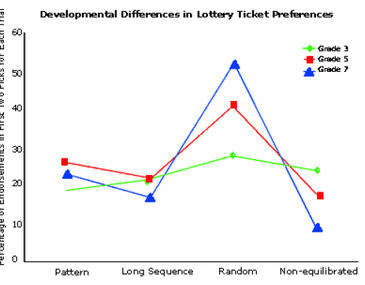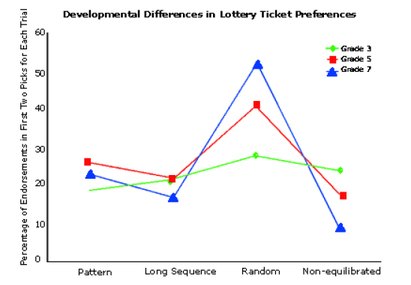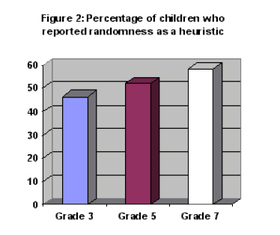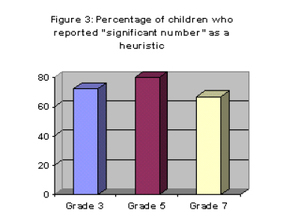The Wager has reviewed studies that highlight youth gambling as a serious and important public health issue. Consistently, meta-analytic evaluation of prevalence studies suggests that gambling problems are quite common among youths (Shaffer, Hall, & Vanderbilt, 1999). The current Wager reports on a cross-sectional study that investigates development changes in children’s cognitive processing while gambling. Specifically, Herman, Gupta, & Derevensky (1998) explored developmental differences in the cognitions and heuristics (mental shortcuts) that children use when choosing lottery ticket numbers. The Wager focuses on children’s selection processes.
With parental permission, 69 third graders, 50 fifth graders, and 48 seventh graders voluntarily participated in this study. Children were asked to rank order their preferences for 16 6/49 lottery tickets.1 Children ranked groups of 8 tickets. Each of the eight tickets belonged to one of four categories identified by the researchers: (1) long series (i.e. “five or six consecutive numbers”), (2) pattern (i.e. “pseudo-logical order”), (3) non-equilibrated (i.e. “six numbers between 1-24 or 25-49”), and (4) random (i.e. “no apparent ordering”). For each group of 8 tickets, children made their rankings by selecting their favorite ticket one at a time. Consistency in ranking between each group of 8 tickets was 28.4% for third graders, 27.3% for fifth graders, and 41.5% for seventh graders. As children were selecting their lottery tickets, they were asked to “think aloud.” Herman et al. (1998) used children’s verbal statements of their thoughts to ascertain the nature of the children’s cognitive and heuristic processing. The researchers recorded both the comments that the children made and the order in which the tickets were selected.
Herman et al. (1998) reported that regardless of age, children overwhelmingly picked lottery tickets categorized as “random” as their favorite tickets.2 However, older children were more likely to select tickets in the random category, over other categorizations, than younger children (Figure 1). The authors suggest that younger children, consequently, might be viewed as displaying more rational gambling behavior (i.e. their choices are not dependent on faulty strategies, but reflect the reality of choices being inconsequential).3
Figure 1
Children’s verbal commentary regarding these choices suggested that when children actually acknowledged selecting tickets because they appeared random, older children did so more frequently than younger children (Figure 2).
However, “random” was not the dominant explanation given by children. Rather, regardless of age, 73.1% of children reported that a “significant number” (i.e. favorite, lucky, or important number) influenced their choices. Only 51.5% of children reported that a ticket’s “randomness” influenced their choice. It is important to note that relative to younger children, older children were less likely to utilize significant numbers in their choices (Figure 3).
The disconnection between children’s actions (selecting tickets categorized as random) and their online verbal reasoning (stating tickets were picked because of a significant number) is suggestive. Such disconnects between actions and words are not uncommon for children and have been reported to indicate that a child is on the verge of learning a new concept (Goldin-Meadow, 1997). Perhaps this accounts for the seemingly conflicting results. Future research might want to consider an expanded age range to see if the results do indeed indicate a transition point in learning or if individuals continue to utilize both randomness strategies and significant number strategies simultaneously. In this study, the number of seventh graders who selected tickets based on randomness, but reported ticket selection based on significant numbers was quite high. More research is needed to determine whether this is unique to this age range, or whether this extends to adolescents and adults.
This study utilizes an interesting methodology to explore children’s heuristics for gambling. Longitudinal research, however, might better demonstrate developmental differences. Using this strategy, investigators could eliminate the potential influence of a cohort effect. Further, it is important to note that the non-strategic patterns observed for third graders’ ticket picks are not necessarily indicative of more rational behavior, as the investigators suggested. To propose that children selected their favorite lottery tickets rationally means that young children did this by conscious choice. It is more likely, however, that young children were unaware of their selection strategies and that they might not have been able to effectively distinguish the different types of lottery tickets. Thus, children might not have consciously chosen their tickets without strategy because they believe strategy is irrelevant. Rather, they likely did so because they were unaware that multiple strategies exist. This is not a rational deliberation. Low consistency among young children’s choices support this suggestion. A mathematical consideration of the ticket choices suggests that the overlap or consistency among youngster’s ticket choices should have been observed about 26% of the time by chance. Third and fifth graders, then, apparently did not choose tickets in a manner that deviates substantially from chance levels.
Nevertheless, this study is informative and draws attention to important issues: children’s understanding and familiarity with topics surrounding gambling and gambling strategy. Whether children initially approach gambling rationally and develop irrational habits over time or approach gambling in ignorance and learn strategy over time remains to be seen. Regardless, early intervention strategies that attempt to thwart the development of faulty logic patterns, such as assuming random tickets are more likely to win than other tickets, can be developed using this research as a foundation.
Notes
1 6/49 lottery tickets require players to choose 6 numbers out of a total of 49 that are possible. All children reported that they were familiar with lottery tickets.
2 No overall percentage was reported.
3 This suggestion is supported with anecdotal evidence that younger children were more likely to report that the lottery was based on luck and their choices did not matter. No empirical evidence for this was provided, however. This makes this support for the “rationality” interpretation tenuous.
References
Goldin-Meadow, S. (1997). When gestures and words speak differently. Current Directions in Psychological Science. 6 (5), 138-143.
Herman, J., Gupta, R., & Derevensky, J. L. (1998). Children’s cognitive perceptions of 6/49 lottery tickets. Journal of Gambling Studies, 14(3), 227-244.
Shaffer, H. J., Hall, M. N., & Vanderbilt, J. (1999). Estimating the prevalence of disordered gambling behavior in the United States and Canada: A research synthesis. American Journal of Public Health, 89, 1369-1376.
The WAGER is a public education project of the Division on Addictions at Harvard Medical
School. It is funded, in part, by the National Center for Responsible Gaming, the
Massachusetts Department of Public Health, the Addiction Technology Transfer Center of
New England, the Substance Abuse and Mental Health Services Administration, and the
Center for Substance Abuse Treatment.







